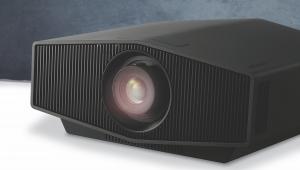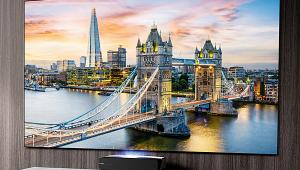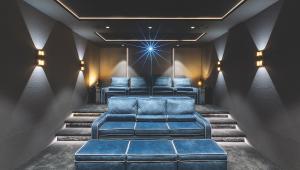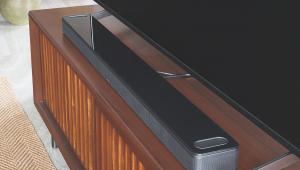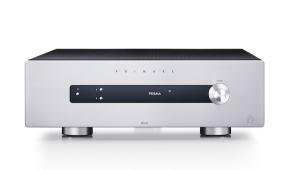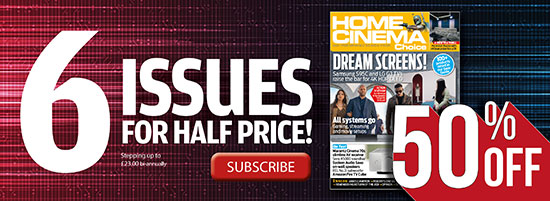JVC DLA-X7 review
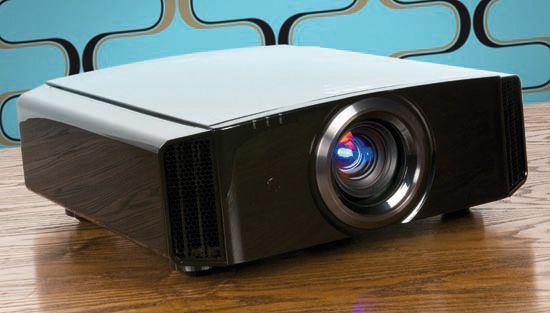
Not everyone ‘gets’ 3D. Indeed, there are days when I’m not sure I totally need it myself. But not so today.
At the root of my sudden 3D love-in is JVC’s new DLA-X7 projector. Regular readers will know that I’ve already tested and thoroughly enjoyed the brand’s entry-level and ridiculously good value DLA-X3. But the step-up X7 really does take quality to another level.
Not that the qualitative leap is obvious from the outside. For, at first glance, it appears identical to the X3, with the same large, vaguely elliptical body shape, impressively polished finish and striking racing car-style vents down either side.
The X7 does weigh slightly more than its sibling for some reason, but really the only obvious external sign of the X7’s step-up status is the addition of a little THX logo on its upper edge...
For dedicated home cinema fans, of course, this logo is potentially very important, as it shows that the X7 has been officially endorsed by the legendary third-party ‘quality assurance’ group. What’s more, the logo refers to the machine’s performance with both 2D and 3D, meaning THX was convinced about such key 3D issues as brightness, colour and crosstalk noise.
Professional thumbs upWhile I’m on the subject of endorsements, the X7 joins the X3 in being supported by the Imaging Science Foundation (ISF), which considers the projector flexible enough to be professionally calibrated by one of its experts.
Among the tools available are fuller colour management tools than you get on the X3 (including a unique option to adjust the picture’s orange balance), a 12-point gamma adjustment system, and lamp output and manual static iris settings. The colour management system is a little unusual in its presentation, but you can get it to bend to your will after a little experimentation.It’s pretty likely, however, that most people buying this projector will have it installed professionally.
The X7’s more basic set-up tools – motorised image shifting, focus and optical zoom – are impressive in terms of both range and the finesse with which you can fine-tune them. And it’s decently connected, with its twin v1.4 HDMIs, D-Sub PC port (the latter not found on the X3), RS232, LAN port and 12V trigger port.
I always find myself wishing for a third HDMI on projectors at the X7’s level, but JVC is hardly alone in sticking with two. One other notable connection is the port that enables you to add JVC’s external 3D transmitter. For, unlike Sony’s VPL-VW90ES active 3D projector, JVC’s models don’t incorporate the necessary 3D transmitter within the main projector chassis. This might annoy some, though actually I think the flexibility it offers in terms of being able to optimise IR transmission angles could be quite handy for some room installations.
More annoying is the fact that JVC only includes one pair of active shutter glasses as standard (though even this is more than you get if you buy the X7 in most other European territories). Peruse the X7’s quoted specifications and you’ll notice that while it has the same 1300 ANSI Lumens of maximum brightness as the X3, it promises a 70,000:1 contrast ratio compared with the X3‘s 50,000:1. And let’s not forget with JVC’s D-ILA projectors that these are native contrast figures.
In other words, you should be able to enjoy a truly extreme contrast performance without seeing the sort of distracting brightness ‘jumps’ you get when other projectors use dynamic irises to achieve better contrast.
And so it proves. For just as I’ve found with so many JVC D-ILA projectors before, the X7 can deliver a contrast range that’s nothing short of awesome. The main contributory factor to this is the X7’s superlative black level response. I simply haven’t seen a better black colour from a projector costing less than five figures. Even better, the deep, rich blacks don’t look forced or dominant, thanks to the appearance of genuine shadow detail and subtle colour differentiation within even the darkest areas.
I felt on occasion as if the X3’s black level response wasn’t quite as good as that of JVC’s previous equivalent model (perhaps as a result of JVC having increased the X series’ brightness output substantially to counteract shutter 3D’s tendency to reduce brightness). With the X7, though, you get the best of both worlds: a significantly boosted brightness boost over last year’s equivalent HD750 model, but also a black level depth at least as good as that of its ground-breaking predecessor. Not surprisingly this combination makes for an image of frequently jaw-dropping dynamism.
Cranked up brightnessIt’s also a combination that serves the X7’s 3D playback extremely well. For where last year’s DLA series would have left 3D looking muted and dull (if they’d been able to display the new format), the 30 per cent boost in brightness JVC has introduced for its current range means the X7’s 3D images look punchy and richly coloured – although as with any serious projector, I’d recommend a completely blacked out room if you want the very best effect.
The X7 also suffers even less with crosstalk ghosting noise than Sony’s VPL-VW90ES. In fact, it seldom bothered me at all, even during scenes such as the notoriously tricky Golden Gate Bridge sequence in Monsters Vs Aliens.
This is very impressive indeed considering how I’ve become an obsessive crosstalk hater over the past 12 months. However, the really good thing about the X7’s 3D pictures is their sheer size. For seeing great 3D discs such as Despicable Me and Avatar delivered well on a screen more than 100in in breadth is enough to win over even the most die-hard 3D sceptic. I’ve seen it happen.
My biggest gripe with the X7’s 3D playback actually doesn’t involve its picture quality. Rather it’s the relatively loud running noise the PJ kicks out when using the high-brightness 3D preset. It’s not unbearable, but it could be enough to persuade some people to sacrifice brightness and switch the lamp power output to its lowest level, which greatly reduces cooling noise.
Fab with flat-o-visionHowever impressive the X7’s 3D pictures might be, 3D viewing will probably only occupy a small proportion of your total viewing time (unless you’re James Cameron). So it’s handy that the X7 is also a terrific 2D projector. On top of its impressive handling of dark sequences are punchy whites that are a big step forward from last year’s models, intense colours and clean motion handling, even without resorting to the provided motion processing circuitry.
I’d also like to commend the X7’s complete freedom from distracting video noise and its terrific sharpness, which did full justice to the exceptionally detailed Blu-ray transfer of The Social Network during my audition period.
The big question for the X7, I guess guess, is whether it can really justify costing nearly twice as much as the X3. In my opinion it can, because it delivers a marked improvement over its cheaper sibling. It’ll be interesting to see how the flagship X9 can be even better...
HCC VERDICT
JVC DLA-X7 3D
Price: £6,500 Approx
Highs: Stunning 2D and 3D pictures; plenty of set-up and calibration flexibility; solid value
Lows: Minor crosstalk with 3D; slightly tricky colour management
Performance: 5/5
Design: 4/5
Features: 5/5
Overall: 5/5
Specifications
3D ready: yes
Full HD: yes Can handle 1080p/24
Component video: yes 1 HDMI: yes 2 x v 1.4
PC input: yes D-Sub 12V trigger: yes 1
Resolution: 1,920 x 1,080
Brightness (claimed): 1300 ANSI Lumens
Contrast ratio (claimed): 70,000:1
Dimensions: 455(w) x 179(h) x 472(d)mm
Weight: 15.1kg
Features: Active 3D playback; 3D transmitter and one pair of glasses included; colour management; x2 optical zoom; high/low lamp modes; noise reduction; motion processing; THX endorsement; ISF support; RS232 jack; motorised image shift; 12-point gamma correction
 |
Home Cinema Choice #351 is on sale now, featuring: Samsung S95D flagship OLED TV; Ascendo loudspeakers; Pioneer VSA-LX805 AV receiver; UST projector roundup; 2024’s summer movies; Conan 4K; and more
|




